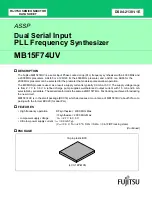
4.3 Modulation
WF1966
4-55
②
Press the
ENTER
key, then use the
and
keys to produce the following display
(SIN
flashes).
S I N
P W M
:
T Y P E D E V I A T I O N F R E Q
F U N C T I O N
③
After selecting, press the
EXIT
key to release the setting mode.
The above completes pulse width modulation setting.
Other operations:
•
When the oscillation mode is changed to modulation (MODU), modulation occurs at the setting at that
time point.
• To stop modulation :
Press the
STOP
key. Resume modulation by pressing the
START
key.
• Duty setting vs. maximum or minimum duties
:
Max. duty = Duty s (pulse width deviation%
÷
2)
Min. duty = Duty setting
−
(pulse width deviation%
÷
2)
•
During modulation, multiple pulses may be output in one cycle, as shown below.
• During modulation, if the oscillation mode of the other channel is changed, modulation stops.
• To start or stop modulation of both channels simultaneously on a manual operation or via
remote control (GPIB or USB),
set both channels to modulation mode and set OPER-COMMON to
on.
O F F
O N
P W M
:
3
F U N C T I O N
O P E R
−
C O M M O N
•
Setting items at pulse width modulation (MODU menu)
TYPE: PWM
DEVIATION (pulse width deviation) [%]
FREQ (modulation frequency) [Hz]
FUNCTION (modulation waveform) [SIN,
,
,
,
]
OPER-COMMON (operation in both channels) [OFF, ON]
Summary of Contents for wf1966
Page 1: ...INSTRUCTION MANUAL NF Corporation WF1966 MULTIFUNCTION SYNTHESIZER...
Page 2: ......
Page 3: ...DA00008200 002 WF1966 2CH 50MHz SYNTHESIZER Instruction Manual...
Page 4: ......
Page 8: ......
Page 20: ......
Page 31: ...3 1 Panel description WF1966 3 3 Front panel...
Page 32: ...3 1 Panel description 3 4 WF1966 Rear panel...
Page 62: ......
Page 158: ......
Page 174: ......
Page 190: ......
Page 192: ......
Page 194: ......
Page 196: ......
Page 197: ......








































